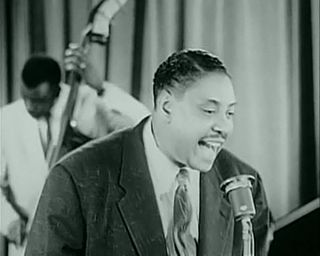
Rhythm and blues, frequently abbreviated as R&B or R'n'B, is a genre of popular music that originated within the African-American community in the 1940s. The term was originally used by record companies to describe recordings marketed predominantly to African Americans, at a time when "rocking, jazz based music ... [with a] heavy, insistent beat" was becoming more popular. In the commercial rhythm and blues music typical of the 1950s through the 1970s, the bands usually consisted of a piano, one or two guitars, bass, drums, one or more saxophones, and sometimes background vocalists. R&B lyrical themes often encapsulate the African-American history and experience of pain and the quest for freedom and joy, as well as triumphs and failures in terms of societal racism, oppression, relationships, economics, and aspirations.
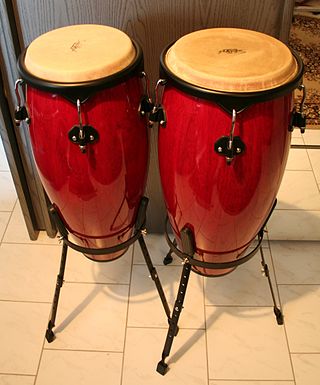
Salsa music is a style of Caribbean music, combining elements of Cuban, Puerto Rican, and American influences. Because most of the basic musical components predate the labeling of salsa, there have been many controversies regarding its origin. Most songs considered as salsa are primarily based on son montuno and son Cubano, with elements of cha-cha-chá, bolero, rumba, mambo, jazz, R&B, rock, bomba, and plena. All of these elements are adapted to fit the basic Son montuno template when performed within the context of salsa.
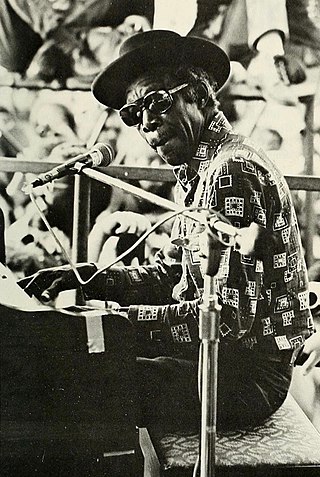
Henry Roeland "Roy" Byrd, better known as Professor Longhair or "Fess" for short, was an American singer and pianist who performed New Orleans blues. He was active in two distinct periods, first in the heyday of early rhythm and blues and later in the resurgence of interest in traditional jazz after the founding of the New Orleans Jazz and Heritage Festival in 1970. His piano style has been described as "instantly recognizable, combining rumba, mambo, and calypso".

Bossa nova is a relaxed style of samba developed in the late 1950s and early 1960s in Rio de Janeiro, Brazil. It is mainly characterized by a calm syncopated rhythm with chords and fingerstyle mimicking the beat of a samba groove, as if it was a simplification and stylization on the guitar of the rhythm produced by a samba school band. Another defining characteristic of the style is the use of unconventional chords in some cases with complex progressions and "ambiguous" harmonies. A common misconception is that these complex chords and harmonies were derived from jazz, but samba guitar players have been using similar arrangement structures since the early 1920s, indicating a case of parallel evolution of styles rather than a simple transference from jazz to bossa nova. Nevertheless, bossa nova was influenced by jazz, both in the harmonies used and also by the instrumentation of songs, and today many bossa nova songs are considered jazz standards. The popularity of bossa nova has helped to renew samba and contributed to the modernization of Brazilian music in general.
Latin jazz is a genre of jazz with Latin American rhythms. The two main categories are Afro-Cuban jazz, rhythmically based on Cuban popular dance music, with a rhythm section employing ostinato patterns or a clave, and Afro-Brazilian jazz, which includes samba and bossa nova.
Son montuno is a subgenre of son cubano developed by Arsenio Rodríguez in the 1940s. Although son montuno had previously referred to the sones played in the mountains of eastern Cuba, Arsenio repurposed the term to denote a highly sophisticated approach to the genre in which the montuno section contained complex horn arrangements. He also incorporated piano solos and often subverted the structure of songs by starting with the montuno in a cyclic fashion. For his approach, Arsenio had to expand the existing septeto ensemble into the conjunto format which became the norm in the 1940s alongside big bands. Arsenio's developments eventually served as the template for the development of genres such as salsa, songo and timba.
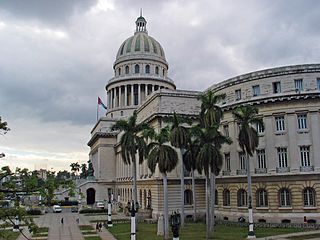
The United States embargo against Cuba has prevented U.S. businesses from conducting trade or commerce with Cuban interests since 1958. Modern diplomatic relations are cold, stemming from historic conflict and divergent political ideologies. U.S. economic sanctions against Cuba are comprehensive and impact all sectors of the Cuban economy. It is the most enduring trade embargo in modern history.
Afro-Cuban jazz is the earliest form of Latin jazz. It mixes Afro-Cuban clave-based rhythms with jazz harmonies and techniques of improvisation. Afro-Cuban music has deep roots in African ritual and rhythm. The genre emerged in the early 1940s with the Cuban musicians Mario Bauzá and Frank Grillo "Machito" in the band Machito and his Afro-Cubans in New York City. In 1947, the collaborations of bebop trumpeter Dizzy Gillespie and percussionist Chano Pozo brought Afro-Cuban rhythms and instruments, such as the tumbadora and the bongo, into the East Coast jazz scene. Early combinations of jazz with Cuban music, such as "Manteca" and "Mangó Mangüé", were commonly referred to as "Cubop" for Cuban bebop.
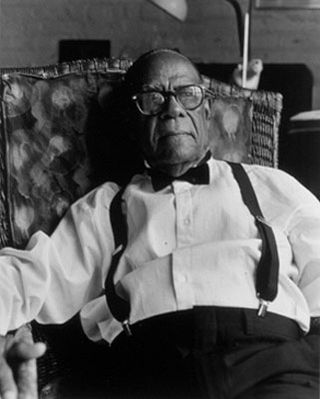
Prudencio Mario Bauzá Cárdenas was an Afro-Cuban jazz, and jazz musician. He was among the first to introduce Cuban music to the United States by bringing Cuban musical styles to the New York City jazz scene. While Cuban bands had had popular jazz tunes in their repertoire for years, Bauzá's composition "Tangá" was the first piece to blend jazz harmony and arranging technique, with jazz soloists and Afro-Cuban rhythms. It is considered the first true Afro-Cuban jazz tune.
An arms embargo is a restriction or a set of sanctions that applies either solely to weaponry or also to "dual-use technology." An arms embargo may serve one or more purposes:
"Footprints" is a jazz standard composed by saxophonist Wayne Shorter and first recorded for his album Adam's Apple in 1966. The first commercial release of the song was a different recording on the Miles Davis album Miles Smiles recorded later in 1966, but released earlier. It has become a jazz standard.
In music of Afro-Cuban origin, tumbao is the basic rhythm played on the bass. In North America, the basic conga drum pattern used in popular music is also called tumbao. In the contemporary form of Cuban popular dance music known as timba, piano guajeos are known as tumbaos.

Jazz drumming is the art of playing percussion in jazz styles ranging from 1910s-style Dixieland jazz to 1970s-era jazz fusion and 1980s-era Latin jazz. The techniques and instrumentation of this type of performance have evolved over several periods, influenced by jazz at large and the individual drummers within it. Stylistically, this aspect of performance was shaped by its starting place, New Orleans, as well as numerous other regions of the world, including other parts of the United States, the Caribbean, and Africa.

The Salmon Tower Building is a 31-story skyscraper located at 11 West 42nd Street and 20 West 43rd Street in Manhattan, New York City, near Bryant Park. It was designed by Albert J. Wilcox and finished in 1928. It was developed by a firm headed by Walter J. Salmon Sr. Directly to the west of the Salmon Tower Building is the former Aeolian Building, and to its east is 500 Fifth Avenue, also built by Salmon Sr.
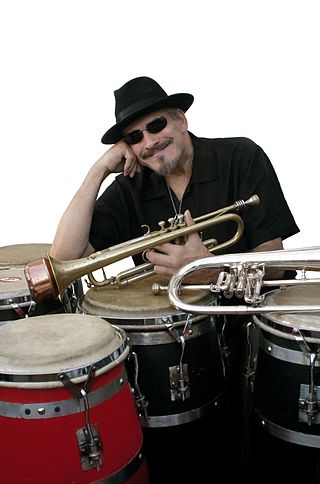
Jerry González was an American bandleader, trumpeter and percussionist of Puerto Rican descent. Together with his brother, bassist Andy González, Jerry Gonzalez played an important role in the development of Latin Jazz during the late 20th century. During the 1970s, both brothers played alongside Eddie Palmieri and in Manny Oquendo's Conjunto Libre, and from 1980 to 2018 they directed The Fort Apache Band. From 2000 to 2018, Jerry González resided in Madrid, where he fronted Los Piratas del Flamenco and El Comando de la Clave. In October 2018, he died of a heart attack after a fire in his home in Madrid.
Tresillo is a rhythmic pattern used in Latin American music. It is a more basic form of the rhythmic figure known as the habanera.

MIRA is a 39-story, 422-foot (129 m) residential skyscraper at 280 Spear Street in San Francisco, California.

Olie Brice is a British double bassist, improviser and composer. He is bandleader of the Olie Brice Quintet, the Olie Brice Trio, and the Olie Brice Octet. Brice has been a member of the Nick Malcolm Quartet, Mike Fletcher Trio, Alex Ward Quintet, Paul Dunmall Brass Project, Loz Speyer's Inner Space, as well as collaborated with Dee Byrne, Tobias Delius, and Binker Golding.
Loz Speyer is a trumpet and flugelhorn player, composer and bandleader. His free jazz quintet Inner Space, and his fusion of Cuban music and jazz 6-piece Time Zone, have both been running since 2002.

Life on the Edge is an album by Loz Speyer's Inner Space, released on Leo Records on 1 February 2017. The five-piece band consists of Speyer, Chris Biscoe, Olie Brice, Rachel Musson, and Gary Willcox (drums).












